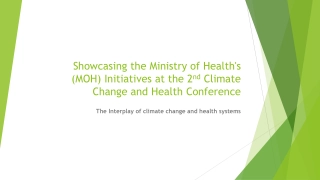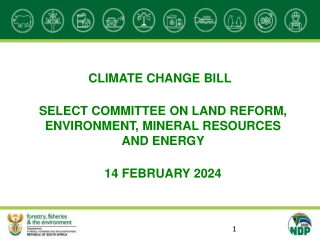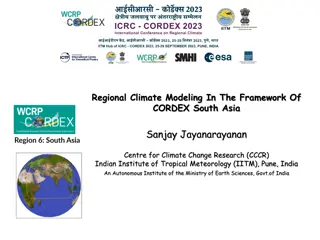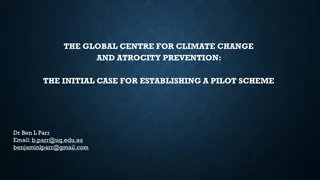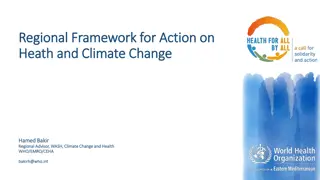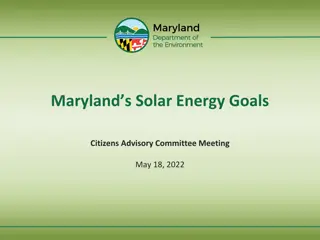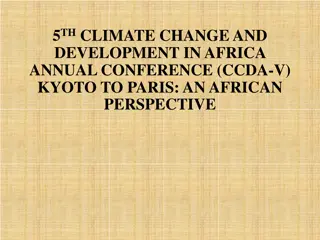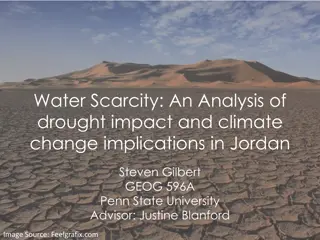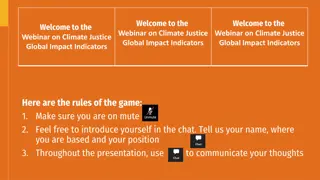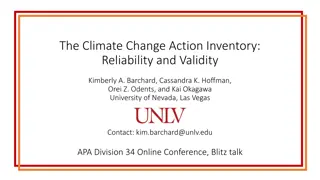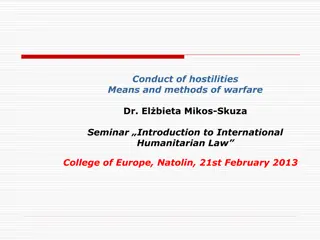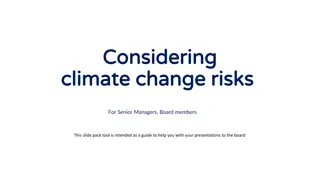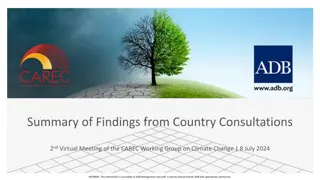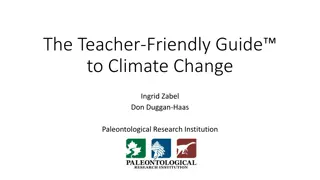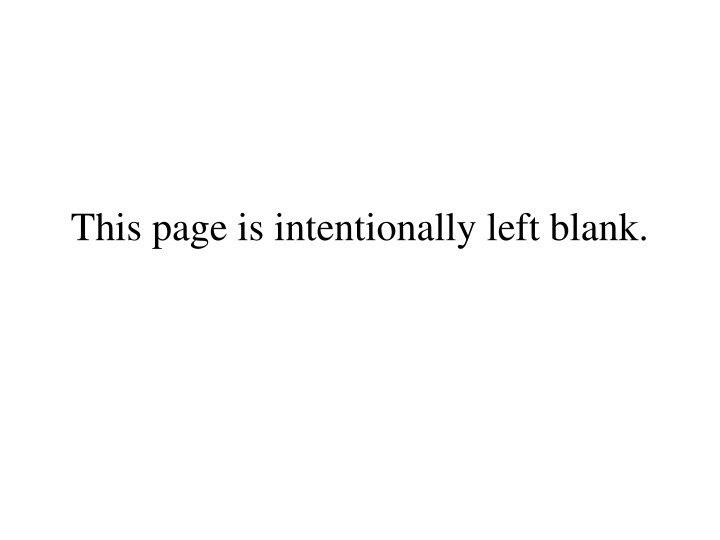
The Evolution from Rio Summit to Kyoto Protocol
Explore the historical progression from the Rio Summit in 1992, which laid the foundation for the United Nations Framework Convention on Climate Change (UNFCCC), to the subsequent Conference of the Parties (COP) meetings and the establishment of the Kyoto Protocol. Learn about the key milestones, including the involvement of Annex I and II countries, in addressing greenhouse gas emissions and promoting sustainable development.
Download Presentation

Please find below an Image/Link to download the presentation.
The content on the website is provided AS IS for your information and personal use only. It may not be sold, licensed, or shared on other websites without obtaining consent from the author. If you encounter any issues during the download, it is possible that the publisher has removed the file from their server.
You are allowed to download the files provided on this website for personal or commercial use, subject to the condition that they are used lawfully. All files are the property of their respective owners.
The content on the website is provided AS IS for your information and personal use only. It may not be sold, licensed, or shared on other websites without obtaining consent from the author.
E N D
Presentation Transcript
Pathway from Rio(1992) to Kyoto(1997)to Bonn(2017) What is Rio Summit/ Earth Summit ? Seed of Rio Summit- Rome Club Report Rome Club Report- Strategic Mineral Resources Led to the concept of Sustainable Development- Subjected to- Exploration of Subterranean Minerals It was a United nations summit, held in Rio de Janeiro (Brazil) in 1992. It led to creation of United Nations Framework Convention on Climate Change (UNFCCC).
1995 Parties to the UNFCCC meet in Berlin (the 1st Conference of Parties (COP) to the UNFCCC) to outline specific targets on emissions What is UNFCCC??????????? United Nations Framework Convention on Climate Change (UNFCCC) Major outcome of Rio Summit / Earth Summit of 1992. It is an international treaty for reducing greenhouse gas emissions. GHGs Nearly every country on Earth is a party to the UNFCCC.
What is Conference of the Parties (COP)???? The nations, who ve signed UNFCCC convention, meet every year to discuss climate change strategy. These meetings are called Conference of the Parties (COP) The first COP (COP 1) was held in Berlin. Third COP (COP 3) held in Kyoto, Japan. It was here the famous Kyoto Protocol came in to existence. 2011: COP held in Durban, S.Africa. 2012: COP held in Doha, Qatar in November 2012
Annex What? List of industrialized countries and economies in transition: US, France, Japan etc. These countries had pledged to reduce their greenhouse gas emissions to 1990 levels by the year 2000.(RED IN COOR AS THEY HAVE ALREADY EMITTED) A sub-group of Annex 1 Countries, these Annex II countries are required to give financial assistance and technology to the developing countries (non-Annex countries). Developing countries like India, Brazil, China. They do not have compulsory binding targets to reduce green house gas emission, although they are encouraged to do it. It gives the list of 6 Green House gases that are responsible for the whole problem. (RED IN COLOR BECAUSE THEY TRAP IR RADIATION ) 1.Carbon dioxide (CO2); 2.Methane (CH4); 3.Nitrous oxide (N2O); 4.Hydrofluorocarbons (HFCs); 5.Perfluorocarbons (PFCs); and 6.Sulphur hexafluoride (SF6) This gives the Annex I countries (Developed countries) compulsory binding targets to reduce green house gas emission. For example USA is required to cut down its emission by 7% Annex I Annex II Non Annex Annex A Annex B
Milestone Achievement Kyoto protocol came into force only after required number of Annex 1 Countries ratified it. So this was achieved only in 2005. Thus, Kyoto although signed in 1997, came into force in 2005.
Kyoto protocol: Explanation with Example You know how broadband internet billing works= there are plans for example 50GB plan for 50$ That means as long as you download music, movies etc. worth less than or equal to 50GB then you ll get bill of $50 but if you download more files above 2GB quota, then company will charge you $1 per MB of extra download. Under Kyoto Protocol, each Annex-B country is given emission target quota (Kyoto Units). For example, for the year 2009, Australia s allowed quota was 2,957,579,143 Kyoto units. (each unit is equivalent to 1 ton of carbon dioxide).
What is common but differentiated responsibilities ? The developed countries such as US,UK have already polluted the atmosphere with greenhouse gases (GHGs) through industrialization. So they re the one who created/started global warming and all the mess. While Developing countries (India and Brazil) have started polluting the world only recently. Therefore, the developing countries such as India, Brazil should share less of the burden of lowering overall emissions. And Developed countries (US,UK) should bear more responsibility in fixing this global warming mess etc. because they re the one more responsible for it. So, while it is the Common responsibility of every nation of this world, to reduce Green house gas emission, but there should be some difference between the responsibility given to developed countries and developing countries. Kyoto Protocol follows that principle and assigns separate responsibilities to the countries.
Emissions Trading / Carbon Trading Suppose two Annex B parties are Japan and Australia. Japan was given quota of 100 units And Australia was given quota of 200 units. But Australian Government is unable to maintain this limit and Australia emits 210 units of green house gas, in given year. On the other side, Japanese Government takes very strong steps to control emission and hence they only emit 90 units of Green House gas. So it has spare 10 Kyoto Units. Now, under Emission trading system, Australia can buy this 10 spare kyoto units from Japan and thus remain within its limit. In real life scenario, each annex B country makes law giving fixed quota to the companies. Suppose steel factory cannot emit more than 1 ton of Green house gas Tire company cannot emit more than 2 tonnes of green house gas. So if tire company owner buys superfine machinaries that produce less gas so he has some spare credit/quota (say 1 ton) While Steel factory emits more than its allowed quota (suppose it was allowed 2 tonnes but emitted 3 tonnes) Then the steel company can pay the tire company and get a certificate that we ve purchase 1 ton quota from this xyz tire company. This Is the essence of Carbon Trading.
2 Clean Development Mechanism (CDM Suppose Annex B country Australia is given emission quota of 200 units, but it emits 210 units of green house gas. But Australia can finance a solar power project in some village of India (Non-Annex or developing Country) and get certificate that the solar plant led to reduction of 10 units of green house gas. In this way, Australia will remain in its quota/limit. Similarly, suppose Australian Government has passed a law that a steel production company with output of 200 tons of steel per a day, must not emit more than 10 units of green house gas in a year. But this company wants to produce more steel, then its green house gas emission has increased to 11 units. (1 more unit above the quota) So this company can also do some solar-projects in India, Brazil etc. and get a certificate that it has led to reduction of 1 unit of GHG emission. = problem solved.
Joint Implementation (JI) This is identical to CDM. In CDM, Australia can do good project in a non-Annex country (developing country) e.g. India. In Joint Implementation, Australia can do the good project in another Annex B country e.g. Japan to meet the quota.
Why USA did not ratify Kyoto Protocol The US signed the Protocol on 12 November 1998, during the Clinton presidency. To become binding in the US, however, the treaty had to be ratified by the Senate, which had already passed the 1997 non-binding Byrd-Hagel Resolution, expressing disapproval of any international agreement that did not require developing countries to make emission reductions and "would seriously harm the economy of the United States". The resolution passed 95- 0.[94]Therefore, even though the Clinton administration signed the treaty,[95]it was never submitted to the Senate for ratification. US President George W Bush refused to ratify Kyoto protocol saying that it would gravely damage the US economy. for example a US steel company would need to either buy Carbon Credits from another company or invest in some projects in a developing country), while an Indian or Chinese Steel company has no such obligation so their cost of production = low, hence they can sell their products @lower MRP = US steel company will loose customers. So US Government feels is that the treaty is fatally flawed, because it does not require developing countries (especially India and China) to commit to emissions reductions. After President Bush, President Obama too, didn t ratify Kyoto protocol for the same reason. (plus we should also understand that the powerful US industrialist lobby may stop election funds to a candidate, if he is in favor of Kyoto protocol, so USA is unlikely to ratify Kyoto or any such future protocols that are legally binding!)
United States China is the world leader in total annual Green House Gas emissions U.S. is second. EU is third. United States is the only Annex I country that has not ratified the Kyoto Protocol. In line with the Copenhagen Accord, the U.S. has pledged a 17% reduction in GHG emissions, against a 2005 baseline, by 2020. (but this is not legally binding).
Canada Quits Kyoto protocol In 2011, Canada, become the first country to quit the Kyoto Protocol on climate change, saying the 1997 accord was handicapped because top green house emitters like the United States and China not covered by it. (Because USA has refused to ratify the treaty and China being an Annex II country has no compulsory responsibility to cut down emission.)
European Union (EU EU is a Party to both the Convention and the Kyoto Protocol. EU is the 3rd largest GHG polluter, accounting for about 12% of global emissions EU states have ratified Kyoto.
Alliance of Small Island State (AOSIS) Not really a player , these are the future victims if green house gas emission is not reduced. AOSIS is an team of 43 small island and low- lying coastal countries (Barbuda, Bahamas, Barbados, Cuba etc.) More green house gas = rise in global temperature = ice melts= sea level rise =many of these areas to become uninhabitable.
The Kyoto mechanisms Under the Protocol, countries must meet their targets primarily through national measures. However, the Protocol also offers them an additional means to meet their targets by way of three market-based mechanisms. The Kyoto mechanisms are: International Emissions Trading Clean Development Mechanism (CDM) Joint implementation (JI)
Key Players in climate change The First commitment period of Kyoto ended in 2012. That s why, the meeting held in (COP18, Doha, Qatar in Nov 2012) was very critical.
In Doha, Qatar, on 8 December 2012, the "Doha Amendment to the Kyoto Protocol" was adopted. The amendment includes: New commitments for Annex I Parties to the Kyoto Protocol who agreed to take on commitments in a second commitment period from 1 January 2013 to 31 December 2020; A revised list of greenhouse gases (GHG) to be reported on by Parties in the second commitment period; and Amendments to several articles of the Kyoto Protocol which specifically referenced issues pertaining to the first commitment period and which needed to be updated for the second commitment period.
On 21 December 2012, the amendment was circulated by the Secretary-General of the United Nations, acting in his capacity as Depositary, to all Parties to the Kyoto Protocol in accordance with Articles 20 and 21 of the Protocol. During the first commitment period, 37 industrialized countries and the European Community committed to reduce GHG emissions to an average of 5% against 1990 levels. During the second commitment period, Parties committed to reduce GHG emissions by at least 18 percent below 1990 levels in the eight-year period from 2013 to 2020; however, the composition of Parties in the second commitment period is different from the first.
BASIC Countries Brazil, South Africa, India and China, This group includes the world s major emerging economies and some of its largest emitters Together, the group accounts for around 30% of global GHG emissions. BASIC countries, along with the US, were the authors of the Copenhagen Accord and will continue to be some of the most influential players in the negotiations. All of the BASIC countries have ratified the Kyoto Protocol. But they re not under any binding obligation to meet a specified target. (because these countries are not part of Annex B countries of Kyoto Protocol). Under the Copenhagen Accord, China and India have pledged to reduce their carbon intensity the amount of GHG emissions per unit GDP by 40-45% and 20-25%, respectively, against 2005 levels by 2020. (again not legally binding). BASIC countries recently met in Brazil in September 2012, and declared their intentions (what they want in COP meeting @Doha, Qatar in Nov.2012): rich countries should take on more of a burden to reduce emissions because of their historical contribution to global warming. new agreement should respect the principles of equity and common but differentiated responsibilities, new Kyoto commitment period should start on January 1, 2013
Monitoring emission targets Under the Protocol, countries' actual emissions have to be monitored and precise records have to be kept of the trades carried out. Registry systems track and record transactions by Parties under the mechanisms. The UN Climate Change Secretariat, based in Bonn, Germany, keeps an international transaction log to verify that transactions are consistent with the rules of the Protocol.
Registry systems under the Kyoto Protocol Emission targets for industrialized country Parties to the Kyoto Protocol are expressed as levels of allowed emissions, or assigned amounts , over the 2008-2012 commitment period. Such assigned amounts are denominated in tonnes (of CO2 equivalent emissions) known informally as Kyoto units . The ability of Parties to add to their holdings of Kyoto units (e.g. through credits for CDM or LULUCF activities) or move units from one country to another (e.g. through emissions trading or JI projects) requires registry systems that can track the location of Kyoto units at all times.
Each registry will operate through a link established with the International transaction log put in place and administered by the UNFCCC secretariat. The ITL verifies registry transactions, in real time, to ensure they are consistent with rules agreed under the Kyoto Protocol. The ITL requires registries to terminate transactions they propose that are found to infringe upon the Kyoto rules.
In verifying registry transactions, the ITL provides an independent check that unit holdings are being recorded accurately in registries. After the Kyoto commitment period is finished, the end status of the unit holdings for each Annex B Party will be compared with the Party s emissions over the commitment period in order to assess whether it has complied with its emission target under the Kyoto Protocol.
Adaptation The Kyoto Protocol, like the Convention, is also designed to assist countries in adapting to the adverse effects of climate change. It facilitates the development and deployment of technologies that can help increase resilience to the impacts of climate change. The Adaptation Fund was established to finance adaptation projects and programs in developing countries that are Parties to the Kyoto Protocol. In the first commitment period, the Fund was financed mainly with a share of proceeds from CDM project activities. In Doha, in 2012, it was decided that for the second commitment period, international emissions trading and joint implementation would also provide the Adaptation Fund with a 2 percent share of proceeds.
The road ahead The Kyoto Protocol is seen as an important first step towards a truly global emission reduction regime that will stabilize GHG emissions, and can provide the architecture for the future international agreement on climate change.
In Durban, the Ad Hoc Working Group on the Durban Platform for Enhanced Action (ADP) was established to develop a protocol, another legal instrument or an agreed outcome with legal force under the Convention, applicable to all Parties.
The ADP is to complete its work as early as possible, but no later than 2015, in order to adopt this protocol, legal instrument or agreed outcome with legal force at the twenty-first session of the Conference of the Parties and for it to come into effect and be implemented from 2020.
Adaptation to the adverse effects of climate change is vital in order to respond to the impacts of climate change that are already happening, while at the same time prepare for future impacts. These webpages explain the activities being undertaken on adaptation under the UNFCCC, including: Activities of the Adaptation Committee and Least Developed Countries Expert Group; Approaches to address loss and damage associated with climate change in developing countries that are particularly vulnerable to the adverse effects of climate change;
Implementing adaptation action through national adaptation plans (NAPs) and programmes of action (NAPA); The Cancun Adaptation Framework, including five clusters: implementation, support, institutions, principles and stakeholder engagement; The Nairobi work programme on impacts, vulnerability and adaptation to climate change; The development and transfer of technologies, research and systematic observation; Supporting adaptation through finance, technology and capacity-building
Development and Transfer of Technology With the Technology Mechanism fully operational, the COP, at Warsaw, adopted the modalities and procedures of the Climate Technology Centre and Network (CTCN), thus ensuring that in 2014 the CTCN would be ready to receive requests for support from developing country Parties. Since COP 19, the secretariat has now received more than 50 nominations by Parties of their national designated entities (NDEs), which will act as national focal points to the CTCN. Technology Executive Committee (TEC) Parties, at Warsaw, considered the joint annual report of the TEC-CTCN submitted to COP 19, which, inter alia, included information on the activities and performance of the TEC in 2013 and key messages for COP 19. The key messages of the TEC were on issues related to technology needs assessments, technology roadmaps, the importance of NDEs and collaborative research, development and demonstration. The COP requested the subsidiary bodies to continue consideration of this joint report at their fortieth sessions.
Climate Technology Centre and Network (CTCN) COP 19 adopted the modalities and procedures of the CTCN and the rules of procedure of the Advisory Board of the CTCN, paving the way for the CTCN to receive requests for support from developing country Parties in 2014. Poznan Strategic Programme on Technology Transfer SBI 39 welcomed the financial and technical support that the GEF will provide to 24 non-Annex I Parties for conducting or updating their technology needs assessments. It invited the GEF to continue to consult with the CTCN, through its Advisory Board and UNEP as the host of the Climate Technology Centre, on the support that the GEF will provide for the work of the CTCN and to report on the concrete results of the consultations at SBI 40.
Kigali Agreement A historic global climate deal was reached in Kigali, Rwanda at the Twenty-Eighth Meeting of the Parties to the Montreal Protocol on Substances that Deplete the Ozone Layer (MOP28) The so called Kigali Amendment which amends the 1987 Montreal Protocol aims to phase out Hydro fluorocarbons (HFCs), a family of potent greenhouse gases by the late 2040s. Growth of HFCs has mainly been driven by a growing demand for cooling, particularly in developing countries with a fast-expanding middle class and hot climates.
Flashpoints of Kigali Agreement Around 197 countries, including India, China and the USA, agreed at Kigali to reduce the use of HFCs by roughly 85% of their baselines by 2045. It amends the 1987 Montreal Protocol. It is proposed to reduce Hydro fluorocarbons (HFCs). The agreement has got three separate pathways for different countries. a) Richer countries like the European Union, the USA and others will start to limit their use of HFCs within few years and make a cut-off of at least 10% from 2019. b) Overall, these countries will reduce them to about 15% of 2010-12 baseline levels by 2036. c) China, Brazil and some other developing countries will freeze Hydro fluorocarbons use by 2024, cutting it to 20% of 2020-22 baseline levels by 2045. d) India is a part of the third group along with Iran, Pakistan, and Saudi Arabia etc. That will be freezing HFCs only by 2028 and reducing them to about 15% of 2024-26 baseline levels by 2047.
Overall, Kigali deal will result in reducing the global temperature rise by 0.50C As it is an amendment to Montreal Protocol, it will bind countries to their HFCs reduction schedules from 2019. There are also penalties for noncompliance Overall, the deal is expected to result in the reduction of an equivalent 70 bn tonnes of carbon dioxide from the atmosphere. The Agreement upholds the principle of Common but Differentiated Responsibilities and Respective Capabilities The countries negotiating at Kigali also agreed to provide adequate financing for HFCs reduction which runs in billions of dollars globally. The agreement at Kigali provides for exemptions for countries with high ambient temperatures to phase down HFCs at a slower pace.
Harmful HFCs Hydro fluorocarbons are widely used in fridges, air-conditioning and aerosols sprays. These are a family of Greenhouse gases. They are at present the fastest growing greenhouse gases with emissions increasing by around 10% every year. They trap thousands of times more heat in the earth s atmosphere than carbon dioxide. These factory-made gases had replaced CFCs under the 1987 Montreal Protocol to protect Earth s fragile protective Ozone layer and heal the ozone hole over the Antarctica. HFC-23, a potent greenhouse gas with global warming potential of 14,800 times more than that of CO2, is a by-product of HCFC-22, which is used in industrial refrigeration.
Detour from Paris agreement The Paris agreement which will come into force by 2020 is not legally binding on countries to cut their emissions. The Kigali Amendment is considered vital for reaching the Paris Agreement target of keeping global temperature rise to below 2-degree Celsius It is a clear statement by all world leaders that the green transformation started in Paris is irreversible and unstoppable.

